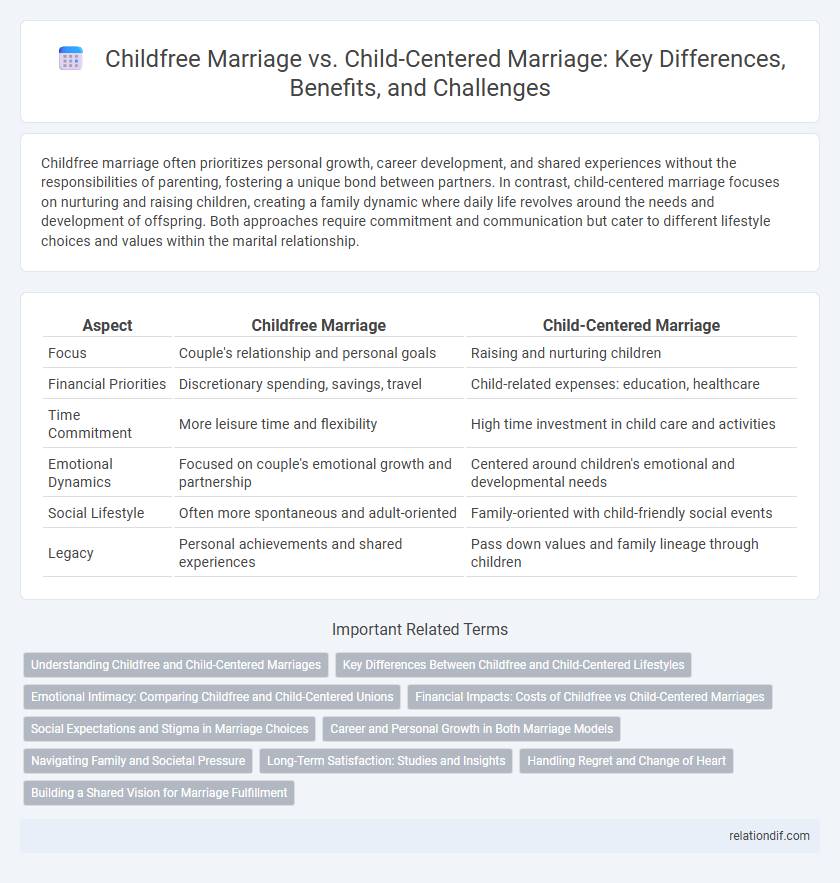Childfree marriage often prioritizes personal growth, career development, and shared experiences without the responsibilities of parenting, fostering a unique bond between partners. In contrast, child-centered marriage focuses on nurturing and raising children, creating a family dynamic where daily life revolves around the needs and development of offspring. Both approaches require commitment and communication but cater to different lifestyle choices and values within the marital relationship.
Table of Comparison
| Aspect | Childfree Marriage | Child-Centered Marriage |
|---|---|---|
| Focus | Couple's relationship and personal goals | Raising and nurturing children |
| Financial Priorities | Discretionary spending, savings, travel | Child-related expenses: education, healthcare |
| Time Commitment | More leisure time and flexibility | High time investment in child care and activities |
| Emotional Dynamics | Focused on couple's emotional growth and partnership | Centered around children's emotional and developmental needs |
| Social Lifestyle | Often more spontaneous and adult-oriented | Family-oriented with child-friendly social events |
| Legacy | Personal achievements and shared experiences | Pass down values and family lineage through children |
Understanding Childfree and Child-Centered Marriages
Childfree marriages prioritize personal freedom, career growth, and shared experiences without the responsibilities of parenting, fostering strong couple intimacy and mutual support. Child-centered marriages focus on raising children, emphasizing nurturing, family dynamics, and long-term planning centered around child development and education. Understanding these distinct priorities helps couples align their values, expectations, and communication strategies for a fulfilling partnership.
Key Differences Between Childfree and Child-Centered Lifestyles
Childfree marriages prioritize personal freedom, career growth, and financial stability, often leading to greater flexibility in lifestyle and decision-making. Child-centered marriages focus on parenting responsibilities, child development, and family dynamics, which can influence daily routines and long-term priorities. Emotional fulfillment in childfree unions often stems from shared adult experiences, while child-centered couples find meaning in nurturing and raising children.
Emotional Intimacy: Comparing Childfree and Child-Centered Unions
Emotional intimacy often differs between childfree and child-centered marriages, with childfree couples frequently experiencing deeper partner-focused connection due to undivided attention and shared interests. In contrast, child-centered unions prioritize familial bonds and nurturing emotions centered around children, which can sometimes diffuse couple intimacy. Research indicates that maintaining emotional closeness in child-centered marriages requires deliberate effort amid parenting responsibilities, while childfree partners may have more opportunities to cultivate ongoing intimate communication.
Financial Impacts: Costs of Childfree vs Child-Centered Marriages
Childfree marriages often experience greater financial flexibility, allocating funds toward personal goals and investments without the substantial costs of child-rearing, which average $233,610 per child in the U.S. by age 18 according to USDA data. Child-centered marriages typically face increased expenses such as education, healthcare, childcare, and extracurricular activities, which significantly impact household budgets. Financial planning in childfree unions can prioritize savings and leisure, whereas child-centered couples must factor long-term child-related expenditures into their economic strategies.
Social Expectations and Stigma in Marriage Choices
Childfree marriages often face societal expectations that equate marital success with parenthood, leading to stigma and judgment from family and community members who prioritize traditional child-centered family models. In contrast, child-centered marriages align more closely with cultural norms, receiving broader social acceptance but sometimes experiencing pressure to conform to idealized parenting roles. Navigating these social dynamics requires couples to reconcile personal choices with external expectations, challenging prevailing narratives about family and fulfillment.
Career and Personal Growth in Both Marriage Models
Childfree marriages often provide greater flexibility for career advancement and personal growth, allowing partners to invest more time and resources into professional development and hobbies. In contrast, child-centered marriages typically require balancing childcare responsibilities, which may limit time for career progression but foster skills in multitasking and time management. Both models present unique opportunities for growth, shaped by individual priorities and life choices.
Navigating Family and Societal Pressure
Navigating family and societal pressure in childfree marriage requires clear communication and firm boundary-setting to uphold personal values amidst external expectations. Childfree couples often face challenges from traditional norms favoring child-centered marriages, where offspring are viewed as a core component of familial success and legacy. Emphasizing mutual respect and shared goals helps childfree partners maintain autonomy and resist societal pressure that prioritizes parenting as a marital obligation.
Long-Term Satisfaction: Studies and Insights
Long-term satisfaction in childfree marriages often stems from increased personal freedom and stronger couple-focused intimacy, as shown in multiple psychological studies. Research indicates that couples without children report higher levels of marital satisfaction and lower stress over time compared to child-centered marriages, which can face challenges related to parenting responsibilities. Insights from longitudinal surveys reveal that while child-centered marriages derive fulfillment from family bonding, childfree couples frequently experience sustained happiness through shared goals and individualized growth.
Handling Regret and Change of Heart
Couples in childfree marriages often navigate regret by openly communicating evolving desires and seeking counseling to reassess their life goals. In child-centered marriages, parents may experience regret related to parenting challenges and find support through community groups or therapy focused on parental well-being. Both relationship models benefit from adaptability and mutual understanding to manage changes of heart and reinforce marital satisfaction.
Building a Shared Vision for Marriage Fulfillment
Childfree couples often prioritize personal growth, mutual interests, and career goals to build a shared vision for marriage fulfillment, fostering deep emotional intimacy and intentional life design. In contrast, child-centered marriages concentrate on parenting roles, family dynamics, and nurturing children's development as central to their marital satisfaction and future planning. Both approaches require clear communication and aligned values to create a fulfilling partnership based on mutual understanding and long-term goals.
childfree marriage vs child-centered marriage Infographic

 relationdif.com
relationdif.com